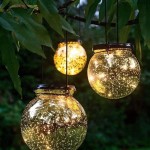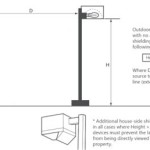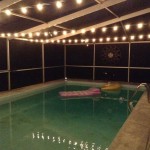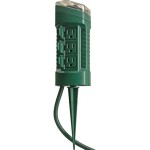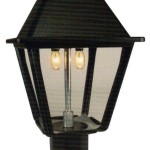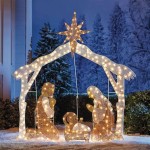CFL Light Bulbs: Outdoor Uses and Considerations
Compact fluorescent lamps (CFLs) have gained widespread popularity as an energy-efficient alternative to traditional incandescent light bulbs. Their ability to produce the same amount of light while consuming significantly less power has made them a common choice for both residential and commercial lighting applications. While CFLs are frequently used indoors, their suitability for outdoor use is a subject that requires careful consideration. Understanding the factors that influence CFL performance and longevity in outdoor environments is crucial for making informed decisions about their application.
This article explores the various aspects of using CFL light bulbs outdoors, including their advantages, disadvantages, environmental considerations, and best practices for ensuring optimal performance. The discussion will delve into temperature sensitivity, weather resistance, and the overall suitability of CFLs for different outdoor lighting scenarios.
Key Points to Consider for CFL Outdoor Use
Several key factors influence the performance and lifespan of CFLs when used outdoors. These factors primarily relate to environmental conditions and the design characteristics of the bulb itself. Paying close attention to these aspects will help ensure that CFLs function efficiently and safely in outdoor settings.
1. Temperature Sensitivity: CFLs are known to be temperature sensitive, meaning that their performance can be affected by extreme hot or cold weather. Low temperatures, in particular, can significantly reduce the light output of a CFL and delay the time it takes for the bulb to reach its full brightness. In very cold conditions, a CFL may not even turn on at all. This is because the mercury vapor pressure inside the bulb, which is essential for the lamp’s operation, decreases at lower temperatures. In contrast, high temperatures can also affect the bulb's lifespan and efficiency, although the impact is generally less pronounced than with cold temperatures.
The ideal operating temperature range for most CFLs is between 25°C (77°F) and 40°C (104°F). When temperatures fall outside this range, the bulb's performance may be compromised. This is a critical consideration when choosing CFLs for outdoor applications in regions with harsh climates. Specific CFL models are designed for cold-weather operation, so it's recommended to select these types of bulbs for areas prone to freezing temperatures. These typically contain a higher fill pressure or a special amalgam to improve their cold-weather starting characteristics.
2. Weather Resistance and Enclosure: Unlike incandescent bulbs, CFLs contain electronic components that are susceptible to damage from moisture and other environmental factors. Therefore, it is essential to protect CFLs from direct exposure to rain, snow, and humidity when used outdoors. Using a fixture designed for outdoor use that provides adequate protection from the elements is crucial. These fixtures typically have weatherproof seals and enclosures that prevent water from entering and damaging the bulb.
The Ingress Protection (IP) rating of the fixture is a valuable indicator of its ability to withstand environmental conditions. Fixtures with higher IP ratings offer greater protection against dust and water intrusion. For outdoor applications, an IP rating of IP44 or higher is generally recommended. This rating indicates that the fixture is protected against splashing water from any direction.
Furthermore, the fixture material should also be considered. Materials like stainless steel or durable plastics are less susceptible to corrosion and degradation from weather exposure, ensuring a longer lifespan for both the fixture and the CFL bulb. It's important to regularly inspect outdoor fixtures for signs of damage or wear and tear and to replace them as needed to maintain proper protection for the CFL bulbs.
3. Light Output and Ambient Lighting: CFLs often produce a different quality of light compared to traditional incandescent bulbs. The color temperature and color rendering index (CRI) of CFLs can vary significantly, and it is essential to choose a bulb that provides the desired lighting effect for the outdoor application. For example, a warmer color temperature (around 2700K) may be preferred for creating a welcoming and inviting atmosphere on a patio or porch, while a cooler color temperature (around 5000K) may be more suitable for security lighting.
The amount of ambient light in the surrounding environment should also be considered when selecting CFLs for outdoor use. In areas with high levels of ambient light, a brighter CFL may be necessary to provide adequate illumination. Conversely, in areas with low ambient light, a lower wattage CFL may be sufficient. It's also important to avoid over-lighting, as this can contribute to light pollution and negatively impact the surrounding ecosystem. Using fixtures with light shields or reflectors can help direct the light downwards and minimize light trespass.
In addition to the color temperature and CRI, the lumen output of the CFL should be carefully considered. Lumen output measures the total amount of visible light emitted by the bulb. Higher lumen output indicates a brighter light. The appropriate lumen output will depend on the specific application and the desired level of illumination. For example, a pathway light may require a lower lumen output than a floodlight used for security purposes.
Specific Outdoor Applications for CFLs
The suitability of CFLs for outdoor use depends on the specific application and the environmental conditions. While CFLs can be used in various outdoor settings, some applications are more appropriate than others. Choosing the right type of CFL and fixture for each application is critical for ensuring optimal performance and longevity.
1. Porch and Patio Lighting: CFLs can be a good choice for porch and patio lighting, especially if the fixtures are enclosed and protected from the elements. Using CFLs in these areas can help reduce energy consumption and lower electricity bills. However, it's essential to choose CFLs with a warm color temperature to create a comfortable and inviting atmosphere. Dimmable CFLs can also be used in porch and patio lighting to adjust the light level according to the desired ambiance.
When selecting CFLs for porch and patio lighting, consider the style and design of the fixtures. CFLs are available in a variety of shapes and sizes, so it's possible to find bulbs that complement the overall aesthetic of the outdoor space. Using decorative fixtures with enclosed globes can further enhance the visual appeal and provide additional protection for the CFL bulbs.
It is crucial to ensure that the fixtures are properly sealed and weatherproofed to prevent moisture from entering and damaging the CFLs. Regular inspection and maintenance of the fixtures are also essential to ensure their continued performance and safety.
2. Security Lighting: CFLs can be used for security lighting, but their slow warm-up time can be a drawback. It can take several minutes for a CFL to reach its full brightness, which may not be ideal for applications where immediate illumination is required. For security lighting, LED bulbs are often a better choice due to their instant-on capability and longer lifespan. However, if CFLs are used for security lighting, it's important to choose bulbs with high lumen output and to ensure that the fixtures are properly aimed to maximize their effectiveness.
Motion-activated security lights are commonly used to deter intruders and enhance safety. When using CFLs in motion-activated fixtures, it's important to consider the bulb's ability to withstand frequent on-off cycles. Frequent switching can shorten the lifespan of CFLs, so it's recommended to choose bulbs that are specifically designed for this type of application. Alternatively, LED bulbs are generally a better option for motion-activated security lights due to their superior durability and instant-on capability.
Proper placement of security lights is also crucial for maximizing their effectiveness. Lights should be positioned to illuminate key areas around the property, such as entrances, walkways, and driveways. Using multiple security lights can provide broader coverage and enhance overall safety.
3. Landscape Lighting: CFLs are generally not recommended for landscape lighting due to their sensitivity to temperature and moisture. Landscape lighting fixtures are often exposed to harsh weather conditions, which can significantly reduce the lifespan of CFL bulbs. Additionally, the aesthetic considerations of landscape lighting often favor the crisp, focused beams of light produced by halogen or LED lamps. The diffused light of a CFL might not provide the desired effect for highlighting specific landscape features.
If CFLs are used for landscape lighting, it is essential to choose fixtures that are specifically designed for outdoor use and that provide adequate protection from the elements. The fixtures should be made of durable materials that can withstand corrosion and weather damage. Regular maintenance and inspection of the fixtures are also important to ensure their continued performance and safety.
Consider the color temperature and lumen output of the CFLs when selecting them for landscape lighting. Warmer color temperatures can create a more inviting and natural look, while cooler color temperatures can provide brighter and more focused illumination. Select fixtures with appropriate shielding to prevent light pollution and minimize glare.
Environmental Considerations and Disposal
While CFLs are more energy-efficient than incandescent bulbs, they contain a small amount of mercury, a toxic substance. Proper disposal of CFLs is essential to prevent mercury from entering the environment. When a CFL bulb breaks, it’s important to follow specific cleanup procedures to minimize exposure to mercury vapor. These procedures typically involve ventilating the area, carefully collecting the broken pieces, and disposing of them properly.
Many municipalities and retailers offer CFL recycling programs. These programs ensure that the mercury in CFLs is safely recovered and that the bulbs are disposed of in an environmentally responsible manner. It is crucial to check with local authorities or retailers to find out about available recycling options in the area. Avoid throwing CFLs in the regular trash, as this can lead to mercury contamination of landfills and the surrounding environment.
Manufacturers are continually working to reduce the mercury content in CFLs and to develop recycling technologies that make it easier and more convenient to dispose of them properly. Furthermore, alternative lighting technologies, such as LED bulbs, are becoming increasingly popular and offer even greater energy efficiency and longer lifespans without the use of mercury. As LED technology continues to improve and become more affordable, it is likely that LED bulbs will eventually replace CFLs as the primary energy-efficient lighting option for both indoor and outdoor applications.
Responsible disposal of CFLs is not just an environmental imperative but also a matter of public health. By taking the necessary precautions and utilizing available recycling programs, individuals and businesses can minimize the risks associated with mercury exposure and contribute to a cleaner and healthier environment.

Compact Fluorescent Lamp Wikipedia

Cfl Bulbs Here S What You Need To Know Diy Family Handyman

Best Outdoor Lighting Bulbs Of 2024

Can I Use This Bulb Outside 1000bulbs Blog

Can I Use This Bulb Outside 1000bulbs Blog

Comparison Of Energy Efficient Bulbs Delmarfans Com

Incandescent Vs Cfl Led Halogen Light Bulbs Elesi Blog

The On Your Porch Seattle Weekly

Cfl Vs Led Lights Which Is The Energy Efficient Light Bulb Green America

Light Bulb Comparison Guide The Lightbulb Co
Related Posts
